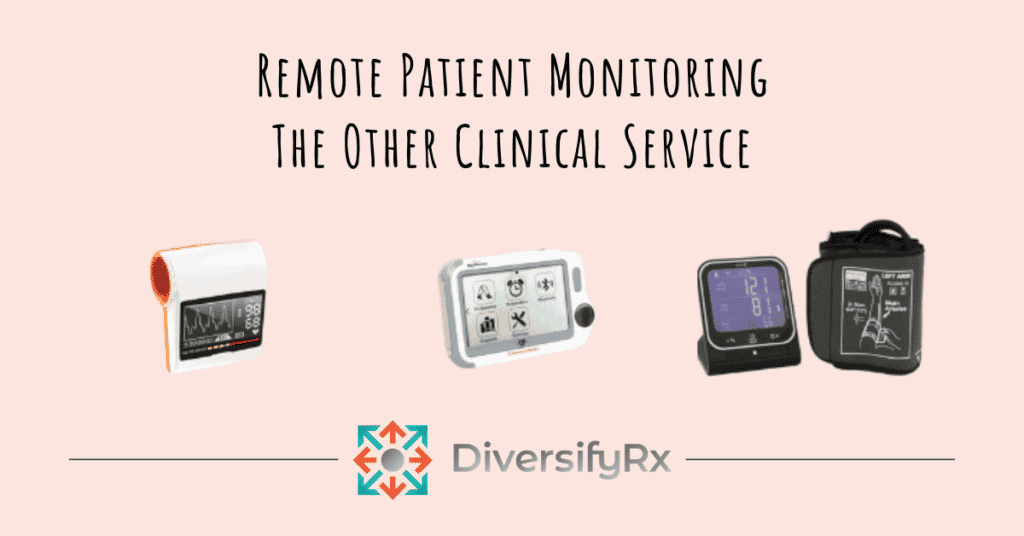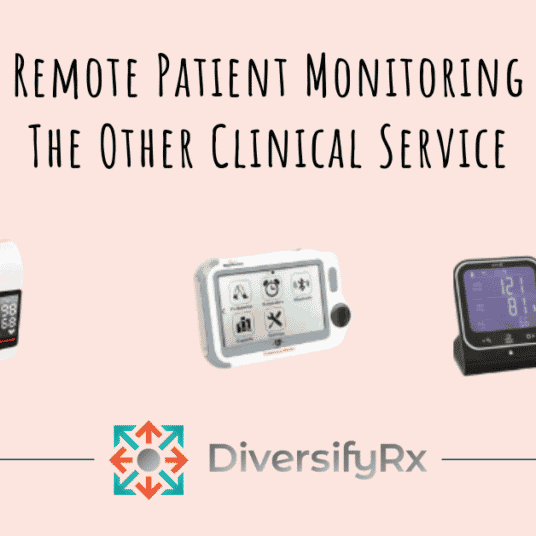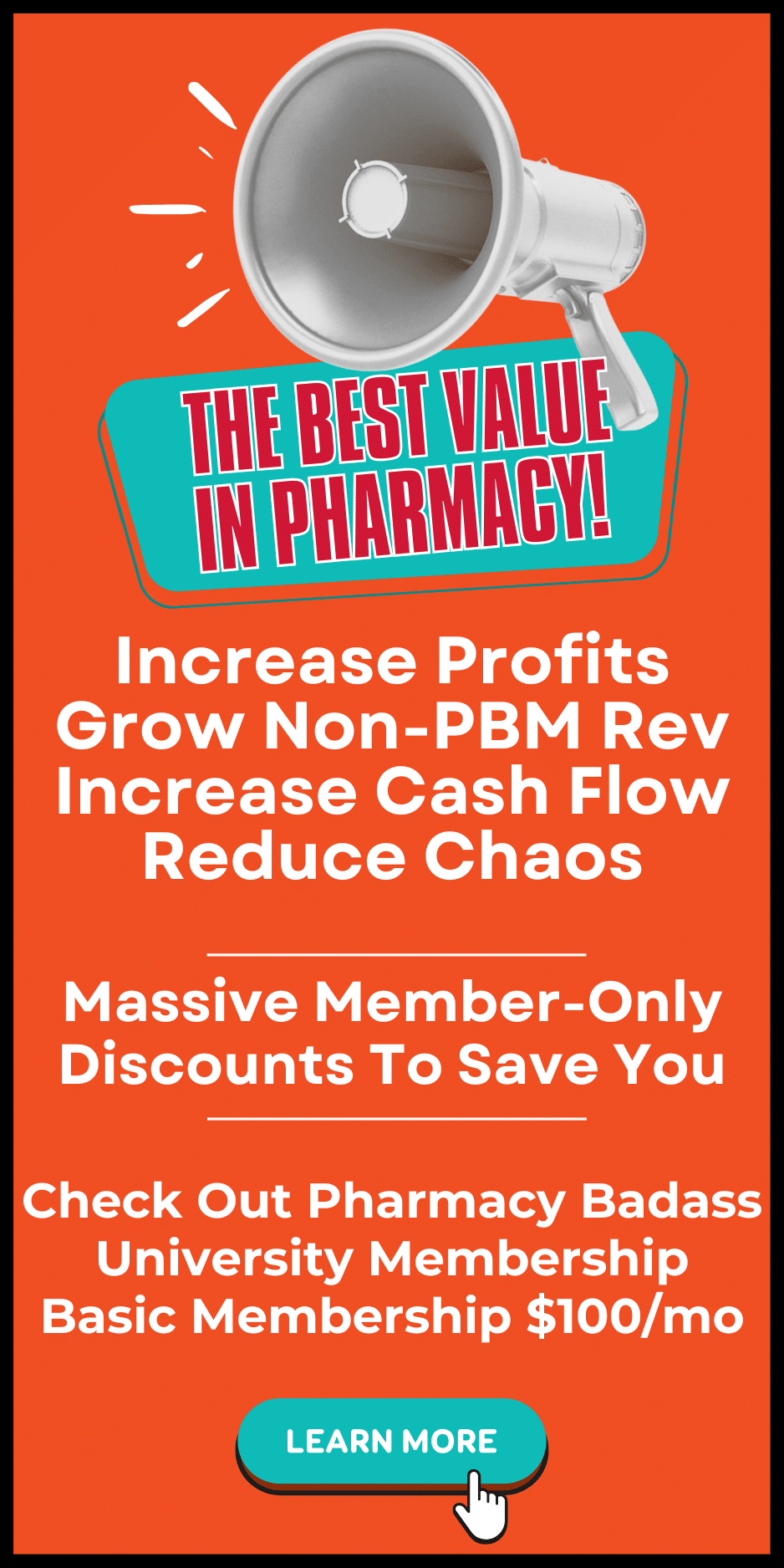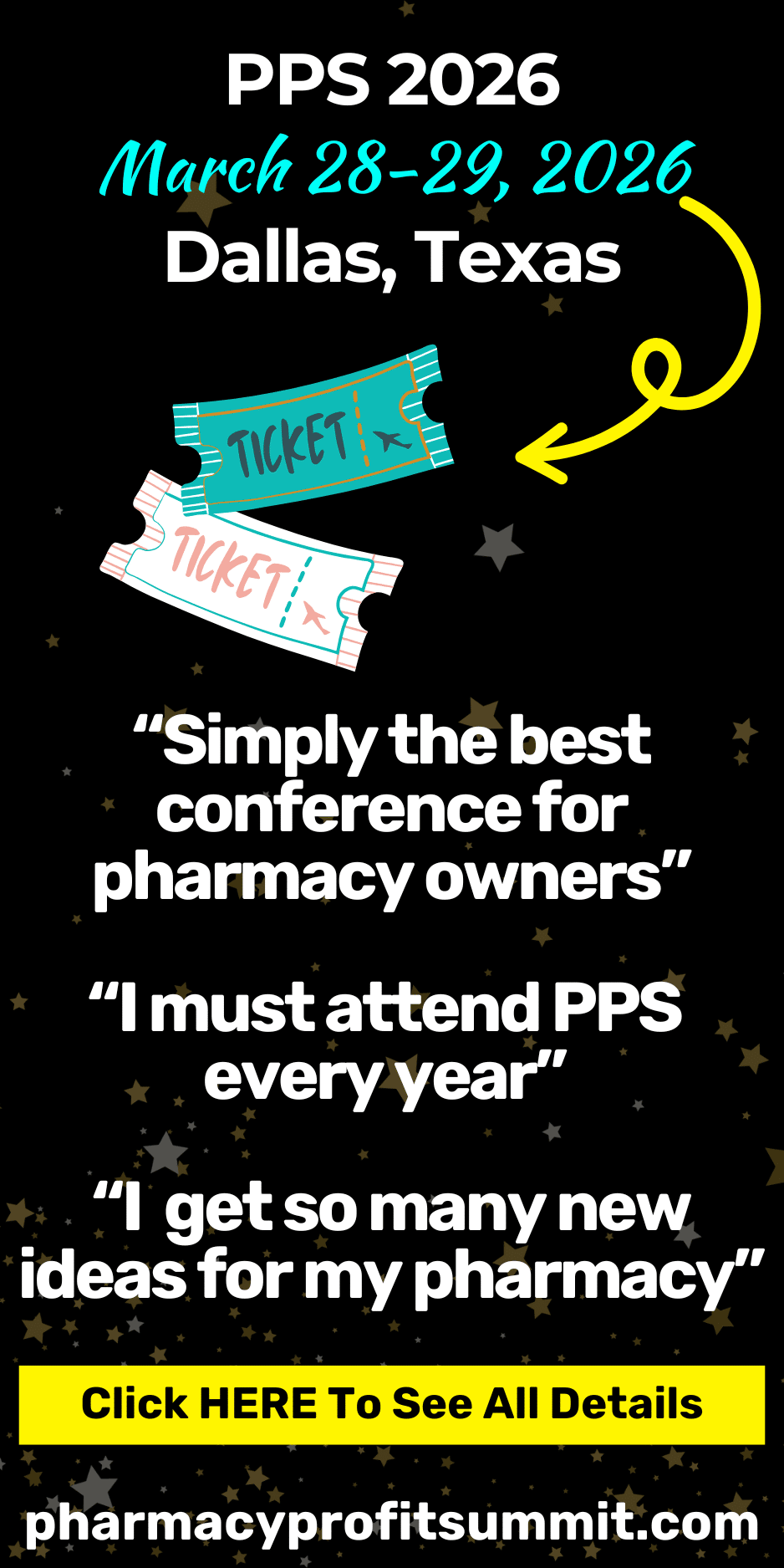Remote Patient Monitoring is DiversifyRx’s pick for the top program of the year for independent pharmacy owners. This post is an expansion of the published article written by Dr. Lisa Faast in America’s Pharmacist Magazine March 2021, “Patient Care Wherever They Are”.
Has the siren of clinical services been calling you?
If you are like other pharmacists and pharmacy owners, you hear the alluring song of non-PBM-based revenue loud and clear. Clinical service revenue is a big umbrella, and it isn’t always obvious where and how to start.
Should you focus on getting collaborative practice agreements?
Do you need more education?
Then the million-dollar question… How will I get paid for my time and expertise?
While annual wellness visits (AWV), chronic care management (CCM), and medication therapy management (MTM) sessions typically get most of this space’s attention, there is another more straightforward and simple path in which to get started. Remote Patient Monitoring (RPM).
What Is RPM?
Remote Patient Monitoring is a professional service enabled by technology that allows patient monitoring outside of a structured clinical setting. Monitoring can take place in the patient’s home or as they go about their normal activities. Additional monitoring gives critical information to the physician to help improve each patient’s treatment plan.
Advances in technology allow for the continuous monitoring of physiological parameters and the secure storage and transmission of this data. RPM services are useful on a wide berth of patients. Here is a list of standard daily monitoring services:
- Continuous blood glucose monitoring
- Blood pressure readings
- Weight
- Pulse rate and oxygen levels
Remote Patient Monitoring Coverage by Medicare
To be covered by Medicare, any remote patient monitoring device must be a medical device as described in section 201(h) of the Federal, Food, Drug, and Cosmetic Act. All devices must also automatically and digitally transfer patient information. The data cannot be reliant on manual uploads or patient self-reporting. The physiological data must be reasonable and necessary to diagnose or treat the patient’s illness or injury or improve a malformed body member’s functioning. Also, the data must be essential to develop and manage a plan of treatment.
Why RPM Matters
Both patients and physicians report having high satisfaction levels with remote patient monitoring.
- 90% of patients want a digital connection with their doctor (mhealth intelligence)
- RPM has improved patient satisfaction (KLAS Remote Patient Monitoring Report 2018)
- Remote patient monitoring improves patient health (KLAS)
- RPM reduces emergency room visits and hospitalizations (KLAS)
- 69% of healthcare professionals rank RPM #1 for reducing overall costs (American Society for Quality)
In addition to improved patient outcomes, RPM provides a new revenue stream for healthcare providers, right when most are experiencing debilitating revenue reductions. Recent Medicare changes make it possible to scale RPM services to a large percentage of a provider’s patient population without hiring new staff or increasing overhead expenses.
The Basics of Billing Remote Patient Monitoring
The five primary Medicare RPM codes are CPT codes 99091, 99453, 99454, 99457, and 99458. While code 99091 has been live for RPM since January 1st, 2018, the other codes are newer and provide much-needed clarity for billing RPM services.
Only a physician, or other qualified healthcare professionals, can bill code 99091. Clinical staff can also bill for codes 99457 and 99458 under general supervision. Lastly, auxiliary staff can bill for codes 99453 and 99454 under general supervision. Auxiliary personnel includes other individuals who are not clinical staff but are employees or leased or contracted employees. CMS has also clarified that RPM services are not diagnostic tests, and therefore they cannot be billed by an independent diagnostic testing facility.
The Details
The CPT language explains that monitoring must occur over at least 16 days of 30 days to bill for CPT code 99454. CMS states that this code is not to be used for a patient more than once every 30 days. Even if a patient has multiple RPM devices, only one instance of code billing can occur during a billing period. CMS also notes that CPT 99453 is billed only once per episode of care, where an episode of care is defined as “beginning when the remote physiologic monitoring service is initiated and ends with attainment of targeted treatment goals.”
To determine if a patient qualifies, the physician would need to determine if daily physiological data is critical to achieving successful outcomes. If the answer is yes, and automated technology will collect and transmit this data, you can enroll them into remote patient monitoring services.
As with all medical billing, you must use a trusted billing partner that understands the CPT language, the Medicare guidelines and ensures that all billing is compliant with the rendered services. Even with the additional RPM billing clarifications from CMS in 2020, there remains some uncertainty, and you should use a billing company intimately familiar with RPM billing.
How Pharmacists Fit In
Under An Auxilliary Company
In the past, RPM placed an enormous burden directly on the physician. This burden prevented the wide adoption of RPM services, and many patients missed out on this beneficial service. With Medicare’s new billing codes and clarification on who can provide which services, pharmacy staff can now perform some RPM tasks. Pharmacies cannot bill Medicare directly for RPM services, but they can contract with physicians and auxiliary companies for flat rate fees for the services they can perform. These services can be completed in the pharmacy by a pharmacist or technician.
Traditional Physician Collaboartion
Pharmacists can also insert into RPM services using the traditional clinical services model, where an embedded pharmacist practices out of a physician’s office. The setup allows the pharmacist to deliver patient care and earn additional revenue, but it still requires a significant time burden on the pharmacist and the physician’s staff.
In either of these models, pharmacists are an extension of the healthcare team. Pharmacists are easily accessible and typically are available for more business hours than most physician offices. Greater accessibility means a better experience for the patient. Independent pharmacies are known for ranking high in patient satisfaction surveys for speed, accuracy, helpfulness, and pharmacists’ knowledge.
When a patient goes to a pharmacy to receive a part of their RPM service, they can also understand how it layers with their pharmacologic therapy. Making changes to treatment in any way can potentially confuse a patient. Being able to spend time with a pharmacist to understand their device and prescription medications is valuable.
Working At The Top Of Your License
Medicare has provided additional clarification on the pharmacists’ role in providing services to beneficiaries. Here is an excerpt of the 2021 fee schedule. “In this CY 2021 PFS proposed rule, we are reiterating the clarification we provided in the May 1st COVID-19 IFC (85 FR 27550 through 27629), that pharmacists fall within the regulatory definition of auxiliary personnel under our “incident to” regulations. Pharmacists may provide services incident to the services, and under the appropriate level of supervision, of the billing physician or nurse practitioner if payment for the services is not made under the Medicare Part D benefit. This includes providing the services incident to the billing physician or NPP’s services and in accordance with the pharmacist’s state scope of practice and applicable state law.”
A Part Of The Team
Pharmacists and pharmacy owners are eager to have all of their employees working at the top of their licenses. By providing clinical services to patients, pharmacists position themselves and the local pharmacy as an integral part of the healthcare team. When you implement remote patient monitoring services as an initial step in this direction, it is relatively risk-free and has a high reward. RPM will insert you directly into the care of the highest-need patients and their prescribers. Forming these relationships and showing pharmacists’ value will benefit your pharmacy and our industry for both the short term and long term.
This all seems complicated, time-consuming, and expensive to get going, right?
The Solution? Leverage your RPM service with an RPM technology company to set up, scale, and deliver service efficiently.
Choosing the Right RPM Partner
Remote patient monitoring service providers are popping up everywhere. How do you know the good from the bad? A good company will offer at a minimum:
- The best in class technology to every patient.
- Daily monitoring and alerts for all patients.
- A HIPAA compliant portal for accessing real-time patient data at any time.
- Strict adherence to all billing requirements.
- Detailed documentation and notes for every minute spent with a patient.
- Transparency for billing, payments, and all activities.
- Actively includes pharmacies and pharmacists as a part of their program.
Ensuring Pharmacists Are A Part Of Remote Patient Monitoring
Many good companies have most of the above qualities. The most common missing component is number seven. Most companies continue to leave pharmacists and independent pharmacies out of the picture. Including pharmacists completes the circle of care for these patients. RPM patients often have chronic conditions that need pharmacological intervention as much as they need technological monitoring. Integrating the local pharmacy into the remote patient monitoring services sets the patient on the most successful path they can be on.
For this reason, we prefer VeruStat’s program offered through RxGenomix. They rely heavily on pharmacists and local pharmacies to help make RPM services successful. PharmDs are an important part of their staff and have a mission to help independent pharmacies thrive. Independent pharmacies are in a unique position to help both physicians and patients with RPM. The majority of physicians are not aware that RPM is now easier than ever to implement. Independent pharmacy owners and pharmacists can leverage your close personal relationships with community physicians and help them implement an RPM program.
Additional Revenues
Flat Rate Payments
Pharmacists ‘ role for RPM services is somewhat limited due to pharmacists not being recognized as providers at the federal level. However, there is still a great opportunity now, and jumping on it will position you perfectly as services and provider status spread to pharmacists. In RxGenomix’s program, pharmacists are paid every month based on the number of patients the pharmacist has interacted with. This payment is recurring as long as the patient stays on RPM care. It roughly comes out to about $10 per patient per month, sometimes more and sometimes less. It’s not much individually, and this program is incredibly easy to scale, and you can have hundreds or even thousands of patients under you.
Back End Opportunities
I learned long ago from my mentor, Dan Benamoz, RPh, that the back-end opportunities are often more profitable than the initial sale. I have found this to be accurate time and time again. A pharmacy owner’s potential goes much deeper than the flat fees earned for helping onboard patients into RPM services. These patients that are walking into your door are your target audience. They are often on medications (a lot of them), and they need help getting healthier. Their health conditions will often qualify them for additional services and products you can provide. Think about offering these patients pharmacogenetic testing (PGx), vaccines, MTMs, therapeutic optimizations, OTCs, supplements, or any other unique services you offer.
To use this program, you DO NOT have to have a CPA or provider status in your state. You also do not have to become an expert in RPM services. There is no selling or upfront costs either!
You can get started with remote patient monitoring in 3 easy steps:
- Talk to RxGenomix and sign up; no costs or requirements. (fill out this form here to get a call)
- Talk to your local doctors that are the primary care for Medicare patients to pique their interest.
- Forward your providers’ information to RxGenomix, who will call on them to educate and invite them to participate.
Once you and a provider partner are ready to enroll patients, you will be trained and walked through the whole process.
Summary
Medicare patients get most of the attention for RPM services since many of the patients who need it are seniors and eligible for Medicare. To stay up to date on Medicare’s guidelines, an excellent place to begin a search is the CMS Newsroom. Their website is cms.gov/newsroom. Private payers and some Medicaids will often also cover RPM services. There is much more variety in the fee schedules on the commercial side, but I have seen them closely follow Medicare.



















